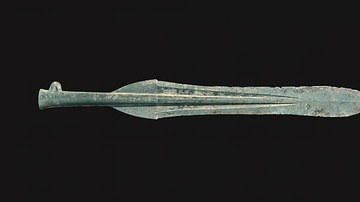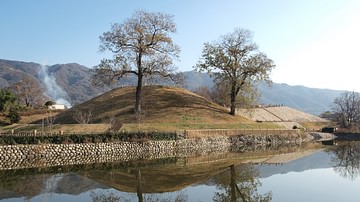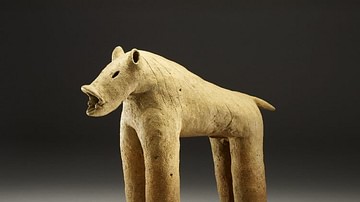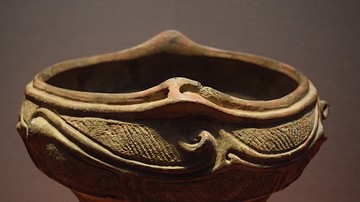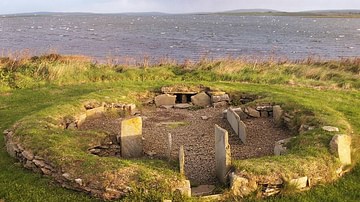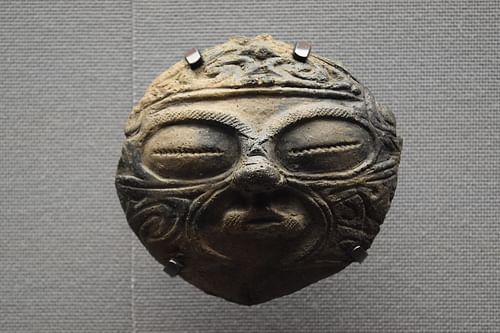
The Jomon Period is the earliest historical era of Japanese history which began around 14500 BCE, coinciding with the Neolithic Period in Europe and Asia, and ended around 300 BCE when the Yayoi Period began. The name Jomon, meaning 'cord marked' or 'patterned', comes from the style of pottery made during that time. Although the entire period is called Jomon, various phases can be identified based on the style and intended use of the pottery.
Settlement & Subsistence
The people that came to what would be known today as Japan first did so near the end of the last glacial period, or Ice Age, most likely while following animal herds over land bridges formed during the glacial period. When the climate warmed and the land bridges disappeared, the soon-to-be Jomon people found themselves on an island. With the animal herds cut off from their homelands dying off, the Jomon people utilized hunting and gathering to fulfil their needs. Their diet has been found to consist of bears, boars, fish, shellfish, yams, wild grapes, walnuts, chestnuts, and acorns. Evidence of their diet was found inside middens, domestic waste disposal piles, and shell mounds that were found near villages.
Starting around 5000 BCE, the Jomon developed a more sedentary lifestyle settling into villages; the largest one at the time covered around 100 acres (c. 0.4 km²) and had about 500 people. Villages near the sea would have relied heavily on fishing while settlements further inland adopted a primarily hunting lifestyle. In many villages, what are assumed to be ceremonial stone platforms and storage pits have been found. The initial simple shelters of the villages would soon develop into pithouses built around a central fireplace, with a structure supported by pillars, accommodating around five people each. The Jomon people would settle in different areas depending on the changing climate; colder periods would require proximity to the sea as evidenced by much larger mounds of shells and fish bones found compared to warmer periods when the settlement pattern shows a shift to further inland sites in order to take advantage of the flourishing flora and fauna.
Along with the change in habitation, the total population underwent significant fluctuation: by 5000 BCE the population would grow from 20,000 to 100,000, only to grow further to 200,000 by 3000 BCE before falling back to 100,000 by the end of the period. Although the Jomon people had a somewhat sedentary life, the agricultural revolution only came with the introduction of rice farming near the end of the Jomon Period. This was around 900 BCE when along with advanced metalworking techniques rice was brought to southwestern Japan from what is today Korea.
Technology
Jomon technology, for the most part, consists of basic stone and wooden tools such as knives and axes as well as bows and arrows, similar to Neolithic technology used in Europe and the rest of Asia. Alongside stone tools, various traps and snares also aided the Jomon people in hunting. Clothing was made from the bark of the mulberry tree, put together using bone needles, and the Jomon were also found to weave wicker baskets. Since at certain periods the Jomon people were settled near the ocean, fishing tools like harpoons and hooks were developed alongside the techniques to use them. Unlike Europe and the rest of Asia, agriculture was not practiced until much later, near the end of the period, so no tools for large-scale farming have been found until the Yayoi period. However, there is evidence of small-scale horticulture or gardening.
Jomon Pottery
Jomon pottery was made by hand, without the use of a potter's wheel, by building up from the bottom coils of soft clay mixed with other materials such as fibers or crushed shells. Afterwards, the outside and inside of the pottery were smoothed out by tools and then fired in an outdoor bonfire. The remains of the Jomon pottery itself are the oldest pottery to be dated in the world, thousands of pieces of which have been found. The pottery used in the earliest part of the Jomon Period, the Incipient (14500 BCE - 5000 BCE), had rounded bottoms and were used to cook outside, steadied on top of a pile of stones or sand. The next form of pottery, used in the Early Jomon (5000 BCE - 3000 BCE), had flat bottoms and was increasingly intended for indoor use. In the Middle Jomon Period (3000 BCE - 1000 BCE), vessels were more elaborately decorated depicting flames or snakes among other things, and in the Late Jomon Period (1000 BCE - 300 BCE), the walls of the pottery became thinner and vessels had a wider array of uses.
Rituals & Beliefs
The Jomon have been found to bury infants in large jars, adults inside pits and shell mounds near villages, and place ceremonial offerings and other ornaments in graves from the Middle to Late Jomon Periods. Starting sometime in the earlier Jomon phases the clay dogu figurines were made and intially started as flat images ranging in size from 3 to 30 centimeters. By the Middle Jomon phase the figurines became more widespread and numerous, and by the Late Jomon phase, the figurines acquired three-dimensional features. Many such figures depicted pregnant women in the hope of boosting fertility or they depicted regular people which were sometimes broken in the belief that any bad luck or illness would pass to the figurine and miss the living person it represented. A common practice for males entering puberty would be ritualistic teeth pulling for unknown reasons. In northern Japan, a number of stone circles have been found around villages dating to the Jomon Period, the purpose of which is not known but theorized to be for a plentiful hunt or fishing.
Transition to the Yayoi
For most of the Jomon Period, Japan was isolated from the rest of Asia so the culture, society, and technology could be called more original and, arguably, more primitive since it could not gain access to the ideas and technology of other cultures. It was not until later phases of the period that evidence was found that indicated contact with the mainland such as similar pottery in Korea, and Kyushu, the southernmost island of Japan. The Jomon people would eventually learn rice growing and metalworking from Korea as well as come into contact with people who would mix with the natives in more southern region. They would become the modern Japanese people, although a small group would maintain a higher percentage of original Jomon DNA far to the north, on the island of Hokkaido.



